High Oxygen Shocking Reduces Postharvest Disease and Maintains Satisfying Quality in Fresh Goji Berries during Cold Storage by Affecting Fungi Community Composition
Abstract
1. Introduction
2. Materials and Methods
2.1. Materials and Postharvest Treatment
2.2. Aerobic Plate Count
2.3. Determination of Decay and Weight Loss
2.4. Determinations of Firmness
2.5. Determinations of Total Soluble Solids (TSS)
2.6. Determinations of Titratable Acidity (TA)
2.7. Fungus Community Dynamics
2.7.1. Collection of Surface Fungi Communities
2.7.2. DNA Extraction, PCR Amplification, and ITS Sequencing
2.7.3. Bioinformatic Analysis
2.8. Statistical Analysis
3. Results
3.1. High Oxygen Shocking Maintained the Good Appearance Quality of Goji Berries
3.2. High Oxygen Shocking Maintained the Good Physiological Quality of Goji Berries
3.3. High Oxygen Shocking Altered the Fungi Community Succession of Goji Berries’ Surface
3.4. High Oxygen Shocking Caused Shifts in Fungi Abundance and Diversity of Goji Berries’ Surface
3.5. High Oxygen Shocking Altered the Fungi Community Structure of Goji Berries’ Surface
3.6. High Oxygen Shocking Changed the Species Distribution of Goji Berries’ Microbiota
3.7. Correlation Analysis between Microorganisms with Quality Properties
4. Discussions
5. Conclusions
Supplementary Materials
Author Contributions
Funding
Data Availability Statement
Acknowledgments
Conflicts of Interest
References
- Levin, R.A.; Miller, J.S. Relationships within tribe Lycieae (Solanaceae): Paraphyly of Lycium and multiple origins of gender dimorphism. Am. J. Bot. 2005, 92, 2044–2053. [Google Scholar] [CrossRef] [PubMed]
- Jatoi, M.A.; Jurić, S.; Vidrih, R.; Vincekovic, M.; Vuković, M.; Jemrić, T. The effects of postharvest application of lecithin to improve storage potential and quality of fresh goji (Lycium barbarum L.) berries. Food Chem. 2017, 230, 241–249. [Google Scholar] [CrossRef] [PubMed]
- Wang, X.; Xu, X.; Chen, Y.; Zhuo, R.; Tian, S.; Li, B. Isolation and identification of postharvest pathogens in fresh wolfberry from Ningxia and the inhibitory effect of salicylic acid. J. Food Saf. Qual. 2018, 9, 5837–5842. [Google Scholar]
- Cheng, J.; Li, T.; Cong, K.; Wu, C.; Ge, X.; Fan, G.; Li, X.; Zhou, D.; Yan, Z.; Li, Y. Effects of dielectric barrier discharge plasma and plasma-activated water on the surface microbial diversity of fresh goji berries during storage. Sci. Hortic. 2023, 313, 111920. [Google Scholar] [CrossRef]
- Lara, I.; Belge, B.; Goulao, L.F. The fruit cuticle as a modulator of postharvest quality. Postharvest Biol. Technol. 2014, 87, 103–112. [Google Scholar] [CrossRef]
- Liu, X.; Gao, Y.; Yang, H.; Li, L.; Jiang, Y.; Li, Y.; Zheng, J. Pichia kudriavzevii retards fungi decay by influencing the fungi community succession during cherry tomato fruit storage. Food Microbiol. 2020, 88, 103404. [Google Scholar] [CrossRef]
- Dai, K.; Han, P.; Zou, X.; Jiang, S.; Xu, F.; Wang, H.; Wei, Y.; Shao, X. Hot air treatment reduces postharvest decay in Chinese bayberries during storage by affecting fungi community composition. Food Res. Int. 2021, 140, 110021. [Google Scholar] [CrossRef]
- Hernández, A.; Ruiz-Moyano, S.; Galván, A.I.; Merchán, A.V.; Pérez Nevado, F.; Aranda, E.; Serradilla, M.J.; de Guía Córdoba, M.; Martín, A. Anti-fungal activity of phenolic sweet orange peel extract for controlling fungi responsible for post-harvest fruit decay. Fungal Biol. 2021, 125, 143–152. [Google Scholar] [CrossRef]
- Mahajan, P.V.; Caleb, O.J.; Singh, Z.; Watkins, C.B.; Geyer, M. Postharvest treatments of fresh produce. Philos. Trans. R. Soc. A Math. Phys. Eng. Sci. 2014, 372, 20130309. [Google Scholar] [CrossRef]
- Zheng, Y.; Yang, Z.; Chen, X. Effect of high oxygen atmospheres on fruit decay and quality in Chinese bayberries, strawberries and blueberries. Food Control 2008, 19, 470–474. [Google Scholar] [CrossRef]
- Nian, Y.; Wang, N.; Li, R.; Shao, Y.; Li, W. Cold shock treatment alleviates chilling injury in papaya fruit during storage by improving antioxidant capacity and related gene expression. Sci. Hortic. 2022, 294, 110784. [Google Scholar] [CrossRef]
- Escobar, M.R.; Ré, M.D.; Sossi, M.L.; Boggio, S.B.; Herrfurth, C.; Feussner, I.; Valle, E.M. Mitochondrial small heat shock protein and chilling tolerance in tomato fruit. Postharvest Biol. Technol. 2021, 175, 111491. [Google Scholar] [CrossRef]
- Lin, Q.; Jiang, Q.; Lin, J.; Wang, D.; Li, S.; Liu, C.; Sun, C.; Chen, K. Heat shock transcription factors expression during fruit development and under hot air stress in Ponkan (Citrus reticulata Blanco cv. Ponkan) fruit. Gene 2015, 559, 129–136. [Google Scholar] [CrossRef] [PubMed]
- Belge, B.; Goulao, L.F.; Comabella, E.; Graell, J.; Lara, I. Postharvest heat and CO2 shocks induce changes in cuticle composition and cuticle-related gene expression in ‘October Sun’ peach fruit. Postharvest Biol. Technol. 2019, 148, 200–207. [Google Scholar] [CrossRef]
- Blanch, M.; Rosales, R.; Palma, F.; Sanchez-Ballesta, M.T.; Escribano, M.I.; Merodio, C. CO2-driven changes in energy and fermentative metabolism in harvested strawberries. Postharvest Biol. Technol. 2015, 110, 33–39. [Google Scholar] [CrossRef]
- Van der Steen, C.; Jacxsens, L.; Devlieghere, F.; Debevere, J. Combining high oxygen atmospheres with low oxygen modified atmosphere packaging to improve the keeping quality of strawberries and raspberries. Postharvest Biol. Technol. 2002, 26, 49–58. [Google Scholar] [CrossRef]
- Liu, X.; Wang, T.; Lu, Y.; Yang, Q.; Li, Y.; Deng, X.; Liu, Y.; Du, X.; Qiao, L.; Zheng, J. Effect of high oxygen pretreatment of whole tuber on anti-browning of fresh-cut potato slices during storage. Food Chem. 2019, 301, 125287. [Google Scholar] [CrossRef]
- Amanatidou, A.; Smid, E.J.; Gorris, L.G.M. Effect of elevated oxygen and carbon dioxide on the surface growth of vegetable-associated micro-organisms. J. Appl. Microbiol. 1999, 86, 429–438. [Google Scholar] [CrossRef]
- Wszelaki, A.; Mitcham, E. Effects of superatmospheric oxygen on strawberry fruit quality and decay. Postharvest Biol. Technol. 2000, 20, 125–133. [Google Scholar] [CrossRef]
- Droby, S.; Wisniewski, M. The fruit microbiome: A new frontier for postharvest biocontrol and postharvest biology. Postharvest Biol. Technol. 2018, 140, 107–112. [Google Scholar] [CrossRef]
- Wei, R.; Ding, Y.; Gao, F.; Zhang, L.; Wang, L.; Li, H.; Wang, H. Community succession of the grape epidermis microbes of cabernet sauvignon (Vitis vinifera L.) from different regions in China during fruit development. Int. J. Food Microbiol. 2022, 362, 109475. [Google Scholar] [CrossRef]
- Lai, D.; Shao, X.; Xiao, W.; Fan, C.; Liu, C.; He, H.; Tian, S.; Kuang, S. Suppression of fruit decay and maintenance of storage quality of litchi by Photorhabdus luminescens Hb1029 treatment. Sci. Hortic. 2020, 259, 108836. [Google Scholar] [CrossRef]
- Goldberg, T.; Agra, H.E.; Ben-Arie, R. Non-destructive measurement of fruit firmness to predict the shelf-life of ‘Hayward’ kiwifruit. Sci. Hortic. 2019, 244, 339–342. [Google Scholar] [CrossRef]
- Barros, R.; Andrade, J.; Denadai, M.; Nunes, M.L.; Narain, N. Evaluation of bioactive compounds potential and antioxidant activity in some Brazilian exotic fruit residues. Food Res. Int. 2017, 102, 84–92. [Google Scholar] [CrossRef] [PubMed]
- Dorey, E.; Fournier, P.; Léchaudel, M.; Tixier, P. A statistical model to predict titratable acidity of pineapple during fruit developing period responding to climatic variables. Sci. Hortic. 2016, 210, 19–24. [Google Scholar] [CrossRef]
- Yu, D.; Zhang, J.; Tan, G.; Yu, N.; Wang, Q.; Duan, Q.; Qi, X.; Cheng, M.; Yan, C.; Wei, Z.; et al. An easily-performed high-throughput method for plant genomic DNA extraction. Anal. Biochem. 2019, 569, 28–30. [Google Scholar] [CrossRef] [PubMed]
- Mago, T.; Salzberg, S.L. FLASH: Fast length adjustment of short reads to improve genome assemblies. Bioinformatics 2011, 27, 2957–2963. [Google Scholar] [CrossRef] [PubMed]
- Bokulich, N.A.; Subramanian, S.; Faith, J.J.; Gevers, D.; Gordon, J.I.; Knight, R.; Mills, D.A.; Caporaso, J.G. Quality-filtering vastly improves diversity estimates from Illumina amplicon sequencing. Nat. Methods 2013, 10, 57–59. [Google Scholar] [CrossRef]
- Knight, R.; Caporaso, J.G.; Kuczynski, J.; Stombaugh, J.; Bittinger, K.; Bushman, F.D.; Costello, E.K.; Fierer, N.; Gonzalez Peña, A.; Goodrich, J.K.; et al. QIIME allows analysis of high-throughput community sequencing data. Nat. Methods 2010, 7, 335–336. [Google Scholar]
- Edgar, R.C.; Haas, B.J.; Clemente, J.C.; Quince, C.; Knight, R. UCHIME improves sensitivity and speed of chimera detection. Bioinformatics 2011, 27, 2194–2200. [Google Scholar] [CrossRef]
- Haas, B.J.; Gevers, D.; Earl, A.M.; Feldgarden, M.; Ward, D.V.; Giannoukos, G.; Ciulla, D.; Tabbaa, D.; Highlander, S.K.; Sodergren, E.; et al. Chimeric 16S rRNA sequence formation and detection in Sanger and 454-pyrosequenced PCR amplicons. Genome Res. 2011, 21, 494–504. [Google Scholar] [CrossRef] [PubMed]
- Edgar, R.C. UPARSE: Highly accurate OTU sequences from microbial amplicon reads. Nat. Methods 2013, 10, 996–998. [Google Scholar] [CrossRef]
- Quast, C.; Pruesse, E.; Yilmaz, P.; Gerken, J.; Schweer, T.; Yarza, P.; Peplies, J.; Glöckner, F.O. The SILVA ribosomal RNA gene database project: Improved data processing and web-based tools. Nucleic Acids Res. 2013, 41, D590–D596. [Google Scholar] [CrossRef] [PubMed]
- Nguyen, N.H.; Song, Z.; Bates, S.T.; Branco, S.; Tedersoo, L.; Menke, J.; Schilling, J.S.; Kennedy, P.G. FUNGuild: An open annotation tool for parsing fungi community datasets by ecological guild. Fungal Ecol. 2016, 20, 241–248. [Google Scholar] [CrossRef]
- Bray, J.R.; Curtis, J.T. An Ordination of the Upland Forest Communities of Southern Wisconsin. Ecol. Monogr. 1957, 27, 326–349. [Google Scholar] [CrossRef]
- Ramette, A. Multivariate analyses in microbial ecology. FEMS Microbiol. Ecol. 2007, 62, 142–160. [Google Scholar] [CrossRef]
- Segata, N.; Izard, J.; Waldron, L.; Gevers, D.; Miropolsky, L.; Garrett, W.S.; Huttenhower, C. Metagenomic biomarker discovery and explanation. Genome Biol. 2011, 12, R60. [Google Scholar] [CrossRef]
- Harsonowati, W.; Masrukhin; Narisawa, K. Prospecting the unpredicted potential traits of Cladophialophora chaetospira SK51 to alter photoperiodic flowering in strawberry, a perennial SD plant. Sci. Hortic. 2022, 295, 110835. [Google Scholar] [CrossRef]
- Noval Rivas, M.; Burton, O.T.; Wise, P.; Zhang, Y.-Q.; Hobson, S.A.; Lloret, M.G.; Chehoud, C.; Kuczynski, J.; DeSantis, T.; Warrington, J.; et al. A microbiota signature associated with experimental food allergy promotes allergic sensitization and anaphylaxis. J. Allergy Clin. Immunol. 2013, 131, 201–212. [Google Scholar] [CrossRef]
- Minchin, P.R. An evaluation of the relative robustness of techniques for ecological ordination. Vegetatio 1987, 69, 89–107. [Google Scholar] [CrossRef]
- Zhang, Y.; Masum, M.I.; Gao, C.; Cheng, Y.; Guan, J. Ozone reduces the fruit decay of postharvest winter jujube by altering the microbial community structure on fruit surface. Microbiol. Res. 2022, 262, 127110. [Google Scholar] [CrossRef]
- Carpita, N.C.; Gibeaut, D.M. Structural models of primary cell walls in flowering plants: Consistency of molecular structure with the physical properties of the walls during growth. Plant J. 1993, 3, 1–30. [Google Scholar] [CrossRef] [PubMed]
- Zhou, H.W.; Sonego, L.; Ben-Arie, R.; Lurie, S. Analysis of cell wall components in juice of flavortop nectarines during normal ripening and woolliness. J. Am. Soc. Hortic. Sci. 1999, 124, 424–429. [Google Scholar] [CrossRef]
- Pan, J.; Shi, Y.; Zhu, S.; Song, Z.; Shi, J. Enhancing the resistance of peach fruit against Monilinia fructicola using exogenous nitric oxide by activating the gamma-aminobutyric acid shunt. Postharvest Biol. Technol. 2023, 200, 112314. [Google Scholar] [CrossRef]
- Zhu, L.; Li, T.; Xu, X.; Shi, X.; Wang, B. Succession of fungi Communities at Different Developmental Stages of Cabernet Sauvignon Grapes From an Organic Vineyard in Xinjiang. Front. Microbiol. 2021, 12, 718261. [Google Scholar] [CrossRef]
- Chen, T.; Nomura, K.; Wang, X.; Sohrabi, R.; Xu, J.; Yao, L.; Paasch, B.C.; Ma, L.; Kremer, J.; Cheng, Y.; et al. A plant genetic network for preventing dysbiosis in the phyllosphere. Nature 2020, 580, 653–657. [Google Scholar] [CrossRef]
- Chen, W.H.; Wu, S.J.; Sun, X.L.; Feng, K.M.; Rahman, K.; Tan, H.Y.; Yu, L.Y.; Li, T.Q.; Xu, L.C.; Qin, L.P.; et al. High-throughput sequencing analysis of endophytic fungi diversity in Cynanchum sp. S. Afr. J. Bot. 2020, 134, 349–358. [Google Scholar] [CrossRef]
- Liu, H.; Carvalhais, L.C.; Crawford, M.; Singh, E.; Dennis, P.G.; Pieterse, C.M.J.; Schenk, P.M. Inner plant values: Diversity, colonization and benefits from endophytic bacteria. Front. Microbiol. 2017, 8, 2552. [Google Scholar] [CrossRef]
- Rondot, Y.; Reineke, A. Endophytic Beauveria bassiana activates expression of defence genes in grapevine and prevents infections by grapevine downy mildew Plasmopara viticola. Plant Pathol. 2019, 68, 1719–1731. [Google Scholar] [CrossRef]
- Camiletti, B.X.; Lichtemberg, P.S.; Paredes, J.A.; Carraro, T.A.; Velascos, J.; Michailides, T.J. Characterization, pathogenicity, and fungicide sensitivity of Alternaria isolates associated with preharvest fruit drop in California citrus. Fungal Biol. 2022, 126, 277–289. [Google Scholar] [CrossRef]
- Mengal, H.S.; Abro, M.A.; Jatoi, G.H.; Nawab, L.; Poussio, G.B.; Ahmed, N.; Zehri, A.Q.; Ali, A. Efficacy of different fungicides, botanical extracts and bio-control agents against Cladosporium cladosporioides, the causal agent of Cladosporium rot in grapes. Acta Ecol. Sin. 2020, 40, 300–305. [Google Scholar] [CrossRef]
- Klein, M.N.; Kupper, K.C. Biofilm production by Aureobasidium pullulans improves biocontrol against sour rot in citrus. Food Microbiol. 2018, 69, 1–10. [Google Scholar] [CrossRef] [PubMed]
- Shi, Y.; Yang, Q.; Zhao, Q.; Dhanasekaran, S.; Ahima, J.; Zhang, X.; Zhou, S.; Droby, S.; Zhang, H. Aureobasidium pullulans S-2 reduced the disease incidence of tomato by influencing the postharvest microbiome during storage. Postharvest Biol. Technol. 2022, 185, 111809. [Google Scholar] [CrossRef]
- Ippolito, A.; El Ghaouth, A.; Wilson, C.L.; Wisniewski, M. Control of postharvest decay of apple fruit by Aureobasidium pullulans and induction of defense responses. Postharvest Biol. Technol. 2000, 19, 265–272. [Google Scholar] [CrossRef]
- Di Francesco, A.; Di Foggia, M.; Zajc, J.; Gunde Cimerman, N.; Baraldi, E. Study of the efficacy of Aureobasidium strains belonging to three different species: A. pullulans, A. subglaciale and A. melanogenum against Botrytis cinerea of tomato. Ann. Appl. Biol. 2020, 177, 266–275. [Google Scholar] [CrossRef]
- Agirman, B.; Erten, H. Biocontrol ability and action mechanisms of Aureobasidium pullulans GE17 and Meyerozyma guilliermondii KL3 against Penicillium digitatum DSM2750 and Penicillium expansum DSM62841 causing postharvest diseases. Yeast 2020, 37, 437–448. [Google Scholar] [CrossRef]
- Di Francesco, A.; Ugolini, L.; Lazzeri, L.; Mari, M. Production of volatile organic compounds by Aureobasidium pullulans as a potential mechanism of action against postharvest fruit pathogens. Biol. Control 2015, 81, 8–14. [Google Scholar] [CrossRef]
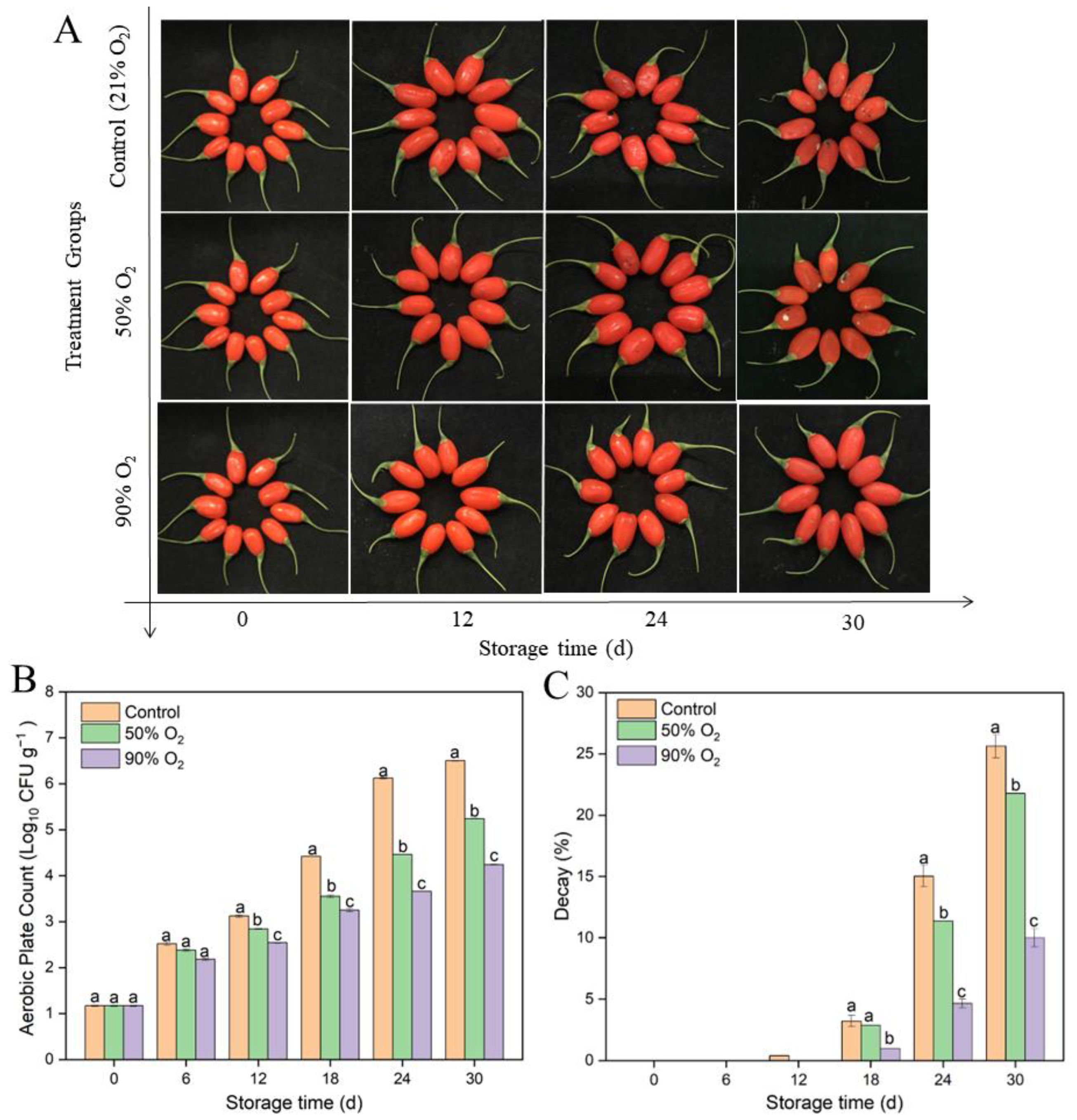
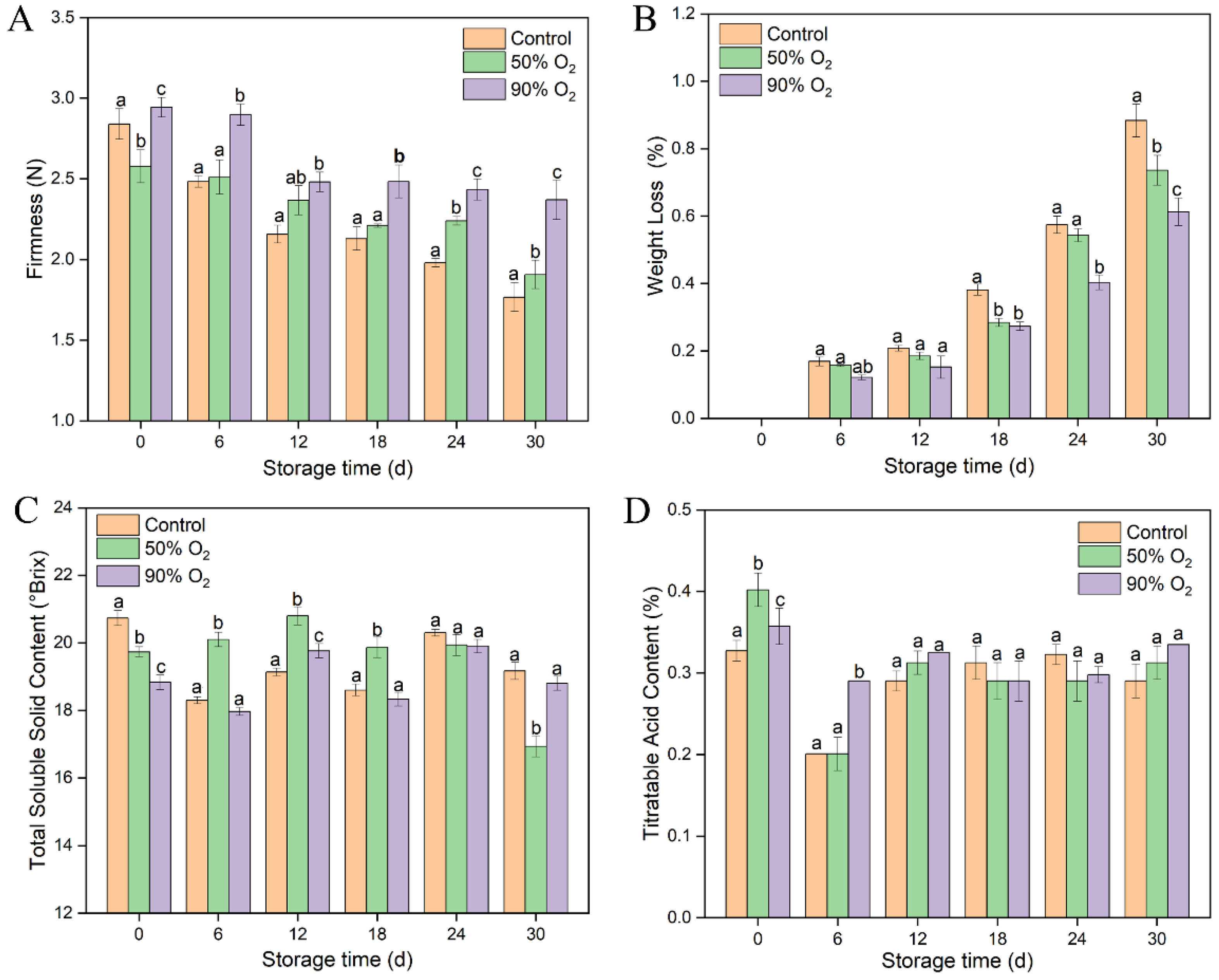
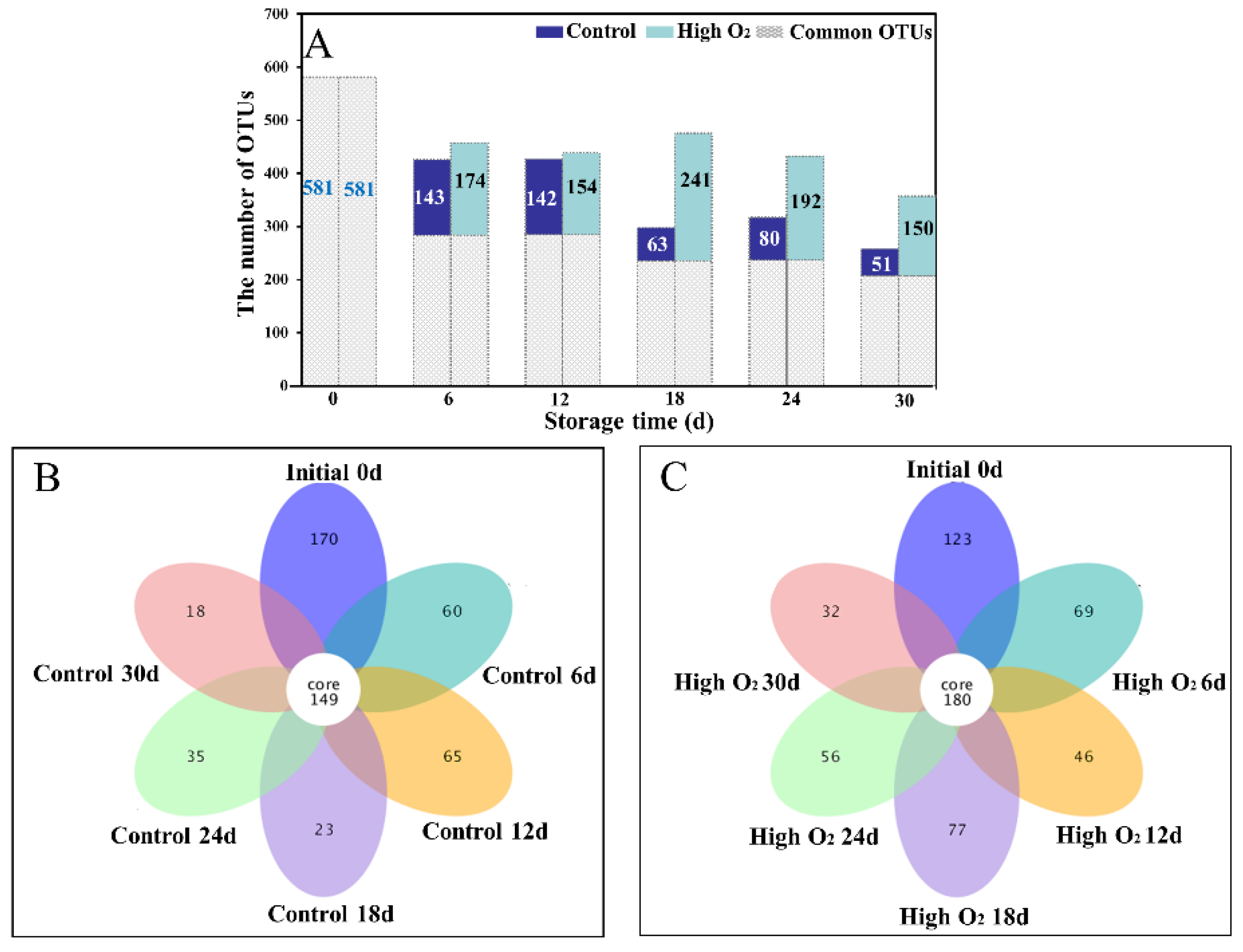

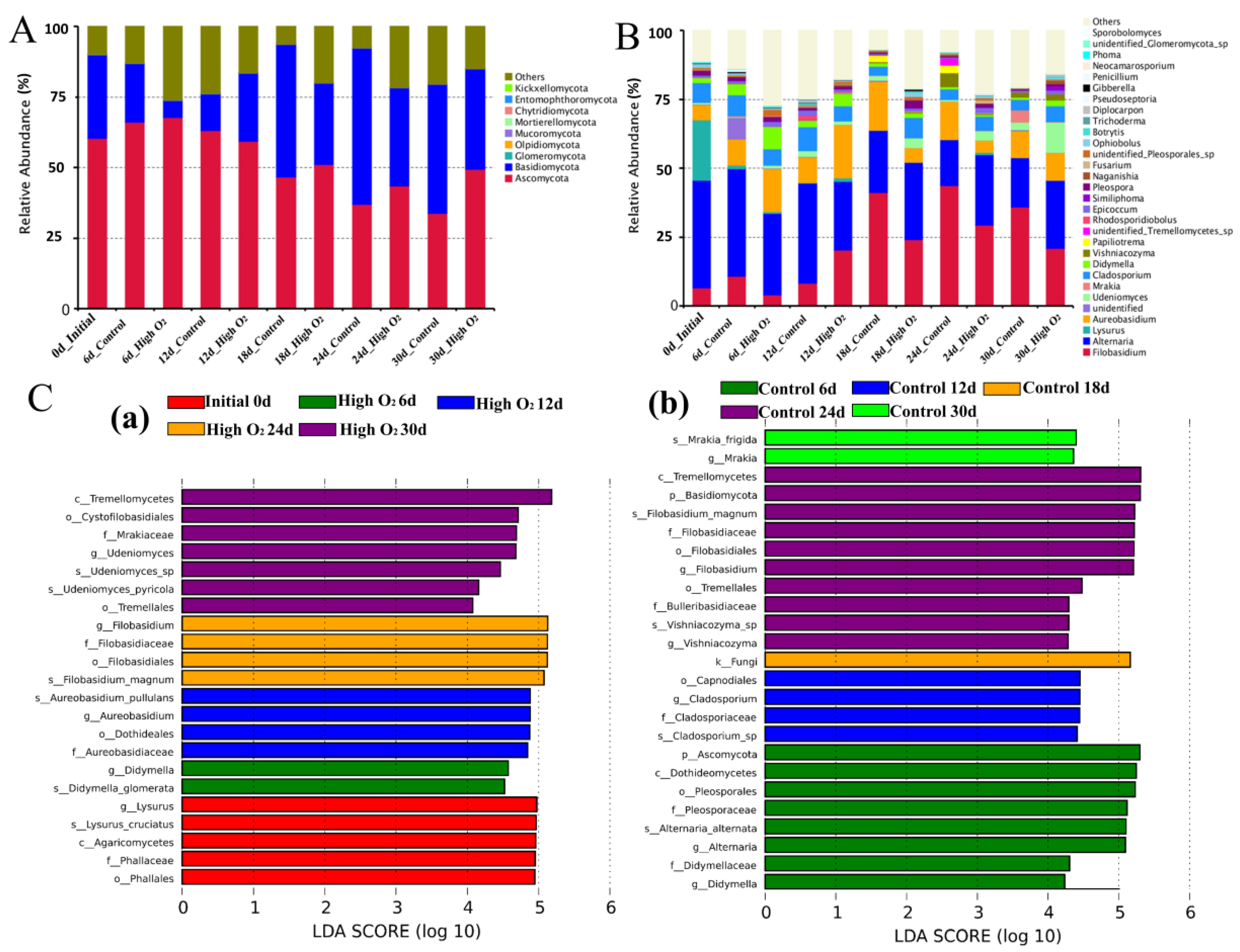
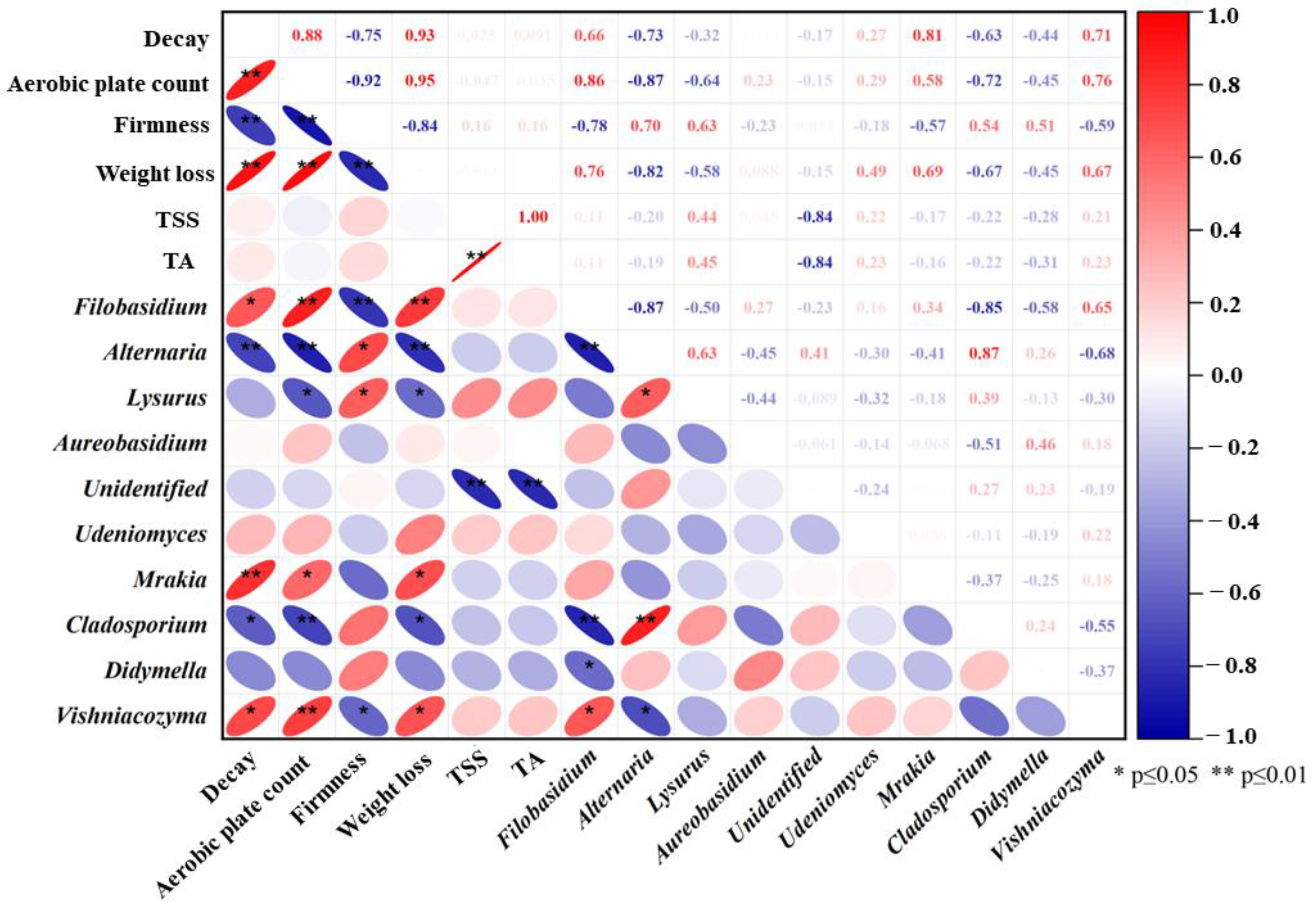
| Samples | Observed Otus | Shannon | Simpson | Chao1 | ACE | Goods Coverage | PD Whole Tree |
|---|---|---|---|---|---|---|---|
| Initial_0d | 360.00 ± 10.54 d | 3.23 ± 0.07 abcd | 0.77 ± 0.02 ab | 400.54 ± 11.94 d | 425.62 ± 19.09 d | 0.999 ± 0.00 a | 95.85 ± 9.15 d |
| Control_6d | 264.33 ± 14.17 c | 3.31 ± 0.06 abcd | 0.80 ± 0.01 ab | 309.82 ± 34.28 bc | 331.54 ± 45.62 bc | 0.999 ± 0.00 a | 62.285 ± 7.92 c |
| High O2_6d | 293.33 ± 4.91 c | 3.44 ± 0.07 cd | 0.83 ± 0.01 ab | 329.53 ± 7.43 c | 344.16 ± 8.75 c | 0.999 ± 0.00 a | 62.52 ± 4.08 c |
| High O2_12d | 274.33 ± 1.45 c | 3.46 ± 0.06 d | 0.84 ± 0.01 ab | 310.79 ± 11.39 bc | 325.59 ± 7.74 bc | 0.999 ± 0.00 a | 56.05 ± 1.00 bc |
| Control_18d | 193.33 ± 10.87 a | 2.86 ± 0.10 a | 0.75 ± 0.01 a | 216.58 ± 15.52 a | 223.06 ± 13.66 a | 0.999 ± 0.00 a | 38.97 ± 2.30 a |
| High O2_18d | 287.67 ± 11.31 c | 3.39 ± 0.17 bcd | 0.81 ± 0.03 ab | 321.90 ± 10.61 c | 343.61 ± 10.32 c | 0.999 ± 0.00 a | 64.97 ± 6.28 c |
| High O2_24d | 272.33 ± 11.92 c | 3.27 ± 0.30 abcd | 0.77 ± 0.07 ab | 303.80 ± 22.32 bc | 318.42 ± 22.21 bc | 0.999 ± 0.00 a | 62.61 ± 5.00 c |
| Control_30d | 171.00 ± 8.00 a | 2.97 ± 0.12 ab | 0.77 ± 0.04 ab | 202.13 ± 21.28 a | 213.84 ± 23.79 a | 0.999 ± 0.00 a | 34.46 ± 1.33 a |
| High O2_30d | 230.67 ± 10.27 b | 3.51 ± 0.18 d | 0.85 ± 0.20 b | 284.01 ± 25.89 bc | 281.36 ± 18.44 abc | 0.999 ± 0.00 a | 44.81 ± 1.56 ab |
Disclaimer/Publisher’s Note: The statements, opinions and data contained in all publications are solely those of the individual author(s) and contributor(s) and not of MDPI and/or the editor(s). MDPI and/or the editor(s) disclaim responsibility for any injury to people or property resulting from any ideas, methods, instructions or products referred to in the content. |
© 2023 by the authors. Licensee MDPI, Basel, Switzerland. This article is an open access article distributed under the terms and conditions of the Creative Commons Attribution (CC BY) license (https://creativecommons.org/licenses/by/4.0/).
Share and Cite
Hou, S.; Zhang, G.; Zhao, W.; Zheng, J.; Xue, M.; Fan, Y.; Liu, X. High Oxygen Shocking Reduces Postharvest Disease and Maintains Satisfying Quality in Fresh Goji Berries during Cold Storage by Affecting Fungi Community Composition. Foods 2023, 12, 2548. https://doi.org/10.3390/foods12132548
Hou S, Zhang G, Zhao W, Zheng J, Xue M, Fan Y, Liu X. High Oxygen Shocking Reduces Postharvest Disease and Maintains Satisfying Quality in Fresh Goji Berries during Cold Storage by Affecting Fungi Community Composition. Foods. 2023; 12(13):2548. https://doi.org/10.3390/foods12132548
Chicago/Turabian StyleHou, Shuangdi, Gaopeng Zhang, Wei Zhao, Jiaxuan Zheng, Min Xue, Yanli Fan, and Xia Liu. 2023. "High Oxygen Shocking Reduces Postharvest Disease and Maintains Satisfying Quality in Fresh Goji Berries during Cold Storage by Affecting Fungi Community Composition" Foods 12, no. 13: 2548. https://doi.org/10.3390/foods12132548
APA StyleHou, S., Zhang, G., Zhao, W., Zheng, J., Xue, M., Fan, Y., & Liu, X. (2023). High Oxygen Shocking Reduces Postharvest Disease and Maintains Satisfying Quality in Fresh Goji Berries during Cold Storage by Affecting Fungi Community Composition. Foods, 12(13), 2548. https://doi.org/10.3390/foods12132548





